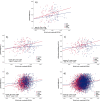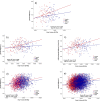Sexual dimorphism in the relationship between brain complexity, volume and general intelligence (g): a cross-cohort study
- PMID: 35773463
- PMCID: PMC9247090
- DOI: 10.1038/s41598-022-15208-4
Sexual dimorphism in the relationship between brain complexity, volume and general intelligence (g): a cross-cohort study
Abstract
Changes in brain morphology have been reported during development, ageing and in relation to different pathologies. Brain morphology described by the shape complexity of gyri and sulci can be captured and quantified using fractal dimension (FD). This measure of brain structural complexity, as well as brain volume, are associated with intelligence, but less is known about the sexual dimorphism of these relationships. In this paper, sex differences in the relationship between brain structural complexity and general intelligence (g) in two diverse geographic and cultural populations (UK and Indian) are investigated. 3D T1-weighted magnetic resonance imaging (MRI) data and a battery of cognitive tests were acquired from participants belonging to three different cohorts: Mysore Parthenon Cohort (MPC); Aberdeen Children of the 1950s (ACONF) and UK Biobank. We computed MRI derived structural brain complexity and g estimated from a battery of cognitive tests for each group. Brain complexity and volume were both positively corelated with intelligence, with the correlations being significant in women but not always in men. This relationship is seen across populations of differing ages and geographical locations and improves understanding of neurobiological sex-differences.
© 2022. The Author(s).
Conflict of interest statement
AMM has received speakers’ fees from Illumina and Janssen, and research support from the Sackler Trust. These are not connected to the current investigation. Remaining authors report no conflicts of interest.
Figures





Similar articles
-
Brain structural complexity and life course cognitive change.Neuroimage. 2012 Jul 2;61(3):694-701. doi: 10.1016/j.neuroimage.2012.03.088. Epub 2012 Apr 10. Neuroimage. 2012. PMID: 22510257
-
Sexual dimorphism of volume reduction but not cognitive deficit in fetal alcohol spectrum disorders: A combined diffusion tensor imaging, cortical thickness and brain volume study.Neuroimage Clin. 2017 May 10;15:284-297. doi: 10.1016/j.nicl.2017.05.006. eCollection 2017. Neuroimage Clin. 2017. PMID: 28560153 Free PMC article.
-
Structural brain complexity and cognitive decline in late life--a longitudinal study in the Aberdeen 1936 Birth Cohort.Neuroimage. 2014 Oct 15;100:558-63. doi: 10.1016/j.neuroimage.2014.06.054. Epub 2014 Jun 30. Neuroimage. 2014. PMID: 24993896
-
Multimodal Image Analysis of Sexual Dimorphism in Developing Childhood Brain.Brain Topogr. 2021 May;34(3):257-268. doi: 10.1007/s10548-021-00823-7. Epub 2021 Feb 25. Brain Topogr. 2021. PMID: 33630209
-
Sexual selection, Machiavellian intelligence, and the origins of psychosis.Lancet. 1993 Sep 4;342(8871):594-8. doi: 10.1016/0140-6736(93)91415-i. Lancet. 1993. PMID: 8102725 Review.
Cited by
-
Age-associated sex and asymmetry differentiation in hemispheric and lobar cortical ribbon complexity across adulthood: A UK Biobank imaging study.Hum Brain Mapp. 2023 Jan;44(1):49-65. doi: 10.1002/hbm.26076. Epub 2022 Sep 15. Hum Brain Mapp. 2023. PMID: 36574599 Free PMC article.
-
Fractal dimension of the cortical gray matter outweighs other brain MRI features as a predictor of transition to dementia in patients with mild cognitive impairment and leukoaraiosis.Front Hum Neurosci. 2023 Sep 26;17:1231513. doi: 10.3389/fnhum.2023.1231513. eCollection 2023. Front Hum Neurosci. 2023. PMID: 37822707 Free PMC article.
-
Efficacy of MRI data harmonization in the age of machine learning: a multicenter study across 36 datasets.Sci Data. 2024 Jan 23;11(1):115. doi: 10.1038/s41597-023-02421-7. Sci Data. 2024. PMID: 38263181 Free PMC article.
-
Novel Isolation Method Reveals Sex-Specific Composition and Neurotoxicity of Small Extracellular Vesicles in a Mouse Model of Alzheimer's Disease.Cells. 2023 Jun 14;12(12):1623. doi: 10.3390/cells12121623. Cells. 2023. PMID: 37371093 Free PMC article.
References
-
- Mandelbrot, B. in Fractals: form, change and dimension. (Freeman, W.H. and co, San Francisco, 1977).
-
- Di Ieva A. The Fractal Geometry of the Brain. Springer; 2016.
Publication types
MeSH terms
Grants and funding
LinkOut - more resources
Full Text Sources

